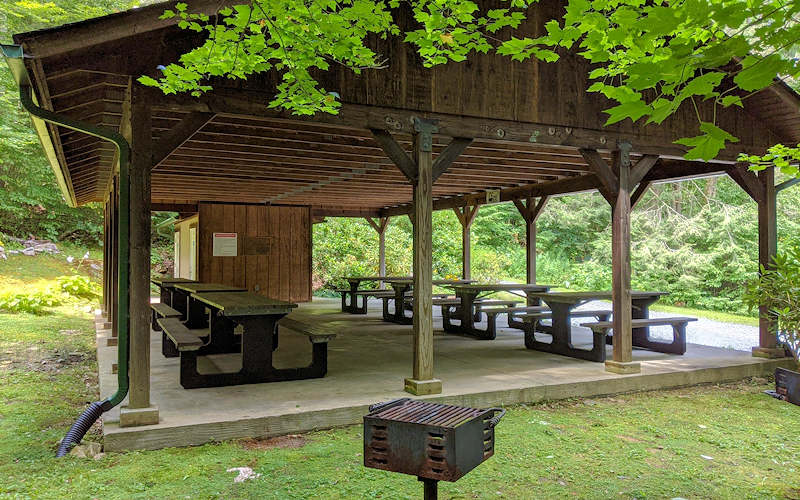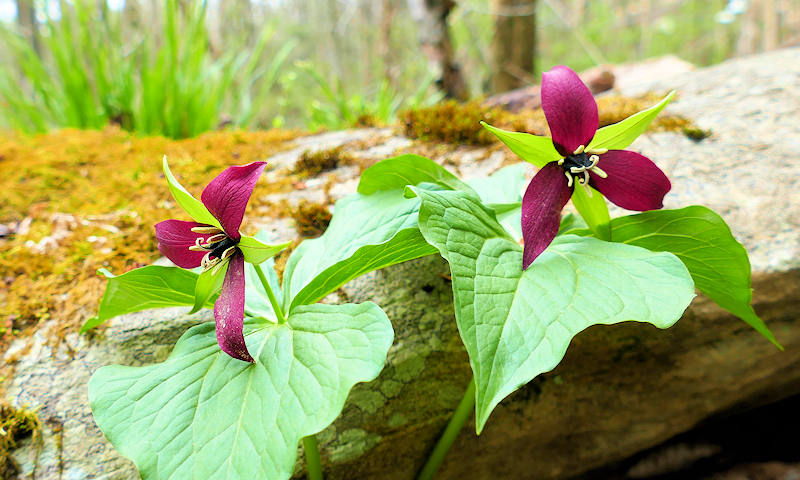
J. Douglas Williams Park is a 14-acre peaceful wooded park in the village of Sugar Mountain with a large picnic pavilion and short nature trails. It’s located on Sugar Mountain Drive about a half mile uphill from the golf and tennis center. The park is open 8 AM until sunset year-round, weather permitting.
Picnic tables and grills are available unless the pavilion is reserved for a group. Alcoholic beverages are permitted, but no glass containers. Please take all garbage with you to keep temptation away from our bears!
Pavilion Group Reservations
To reserve the entire pavilion for a gathering or reunion, call the Village Hall at 828-898-9292. Cost for a 3-hour booking is $25 for residents and $35 for non-residents: download and complete this application.

Hiking Trails
Three shorter trails combine for more than a half-mile hike. A quarter-mile nature trail loop begins past the pavilion (follow gravel road to the end and to right of pump house), crosses a creek and winds through the hardwood forest. It ends at the park entrance road. Two additional short trails take you down the opposite side of the park road along each side of the cascading Bee Branch through the boulder field. The wider trail that begins near the parking area goes to “Bob Ragin Rock” to honor his work to create this park. Find benches along the way to rest and enjoy the scenic setting.
Unique Ecology & Geology of the Park
The J. Douglas Williams Park was preserved and developed by the Sugar Mountain Community Association and given to the Village of Sugar Mountain. A conservation easement placed in 2004 by Blue Ridge Conservancy provides environmental and scenic protection for forests and wildlife habitat, as well as recreational and educational opportunities.
The park (elevation 4,000-4,200 feet) is classified as a Southern Appalachian Northern Hardwood Forest, a globally imperiled community type defined by the NC Natural Heritage Program. These forests are found on high and sheltered slopes with deep rocky soils at elevations above 3500 ft. This forest type has a global rank of G3, meaning it is very rare and localized.
The forest is characterized by Yellow Buckeye, Yellow Birch and Sugar Maple in the canopy, Mountain Maple in the shrub layer and Blue Cohosh in the herb layer. This combination creates habitats for wild turkey, rabbit, squirrel, deer, birds and other wildlife.
The park also includes headwater streams and a fragile riparian habitat, an area adjacent to flowing water that contains elements of both aquatic and terrestrial ecosystems. Two tributaries in the park join Bee Branch, a tributary to the Elk River in the Watauga River Basin. These waters eventually flow into the Tennessee, Ohio and Mississippi Rivers.
Our mountain was once 10 times higher than today. Erosion over hundreds of millions of years has carried away most of the rocks to form thick layers of sediment. Sugar Mountain is located just west of the Eastern Continental Divide that separates waters flowing to the Atlantic Ocean from those flowing to the Gulf of Mexico.
The most distinctive natural community in the park is the Boulder Field Forest – an uncommon high-elevation natural community that occurs where large, deep boulders cover the ground, generally on steep, north-facing slopes which have a cool microclimate. Thin soil deposits fill between the boulders. These closed-canopied forests are dominated by yellow birch due to its ability to root upon boulders. Of the 31 animal species identified on the park land, two watch list species have been observed: Pigmy Salamander and the red-breaster Nuthatch.
Sugar Mountain’s subtropical highland climate with cool humid summers and snowy winters certainly creates a very unique environment for both humans and wildlife to enjoy together. Each winter, we are in a prime location for Northwest Flow Snows.

Spring Wildflowers
Visit each April and May for an explosion of blooms. Here’s a sampling of April blooms:
- Dutchman’s Breeches (Dicentra cucullaria)
- Squirrel Corn (Dicentra canadensis)
- Roundleaf violet (Viola rotundifolia)
- Spring Beauty (Claytonia caroliniana)
- Hobblebush (Viburnum lantanoides)
- Southern Wake Robin (Trillium erectum, Trillium sulcatum)
- Common Violet (Viola sororia)
- Halberd leaf violet (Viola hastata)
- Canadian Violet (Viola canadensis)
- Miterwort (Mitella diphylla)
- Trout lily (Erythronium umbilicatum)
- Hairy Chickweed (Stellaria pubera)
- Cutleaf toothwort (Cardamine concatenata)
Park Address: 1804 Sugar Mountain Drive, Sugar Mountain
Go to our Hiking & Waterfalls Guide for more places to explore.
